If you need to view a user password in Windows 10, unfortunately, it’s not as straightforward as it seems due to security reasons. However, there are ways to reset or recover passwords using built-in Windows tools. Here’s a quick overview: you can use the Command Prompt to reset passwords or access stored Wi-Fi passwords through the Network Settings. Read on for the detailed steps.
In this guide, you’ll learn how to reset a user password using the Command Prompt and view stored Wi-Fi passwords in Windows 10’s settings.
Step 1: Open Command Prompt as an Admin
To begin, you’ll need to open the Command Prompt with administrative privileges.
You can do this by typing «cmd» into the search bar, right-clicking on «Command Prompt,» and selecting «Run as administrator.»
Step 2: Reset the User Password
Once the Command Prompt is open, type the command net user username newpassword and press Enter.
Replace «username» with the account name and «newpassword» with the new password you want to set. This method allows you to reset the password without knowing the old one.
Step 3: Open Network Settings
To view stored Wi-Fi passwords, first, navigate to the Network & Internet settings.
You can do this by clicking on the Start button, then «Settings,» followed by «Network & Internet.»
Step 4: Access Network and Sharing Center
Within the Network & Internet settings, click on «Status» and then select «Network and Sharing Center.»
This will bring up more detailed network options and settings.
Step 5: View Wi-Fi Password
Next, click on your Wi-Fi network name. A new window with Wi-Fi status should pop up, then click on «Wireless Properties.»
Under the «Security» tab, check the «Show characters» box to reveal the Wi-Fi password.
After completing these actions, you will have successfully reset a user password and viewed a stored Wi-Fi password. Keep in mind that you should use these methods responsibly and only with accounts and networks you have permission to access.
Tips for Viewing User Password in Windows 10
- Always run Command Prompt as an administrator to ensure you have the necessary permissions.
- Reset passwords only for accounts you have authorization to access.
- Use strong, unique passwords when resetting to enhance security.
- Keep a backup of all your passwords in a secure location.
- Regularly update your passwords to maintain account security.
Frequently Asked Questions
Can I view user passwords directly in Windows 10?
No, Windows 10 does not allow you to view stored passwords directly for security reasons. You can only reset or recover them.
What should I do if I forget my Windows 10 password?
You can use a password reset disk or the Command Prompt to reset it. Alternatively, you can use Microsoft’s account recovery options if it’s linked to an online account.
Is it safe to show Wi-Fi passwords in Windows 10?
Yes, it’s generally safe if you’re the only one accessing your computer. However, avoid sharing passwords carelessly.
Can I recover a forgotten Wi-Fi password?
Yes, you can view it through the Network and Sharing Center as long as you’re connected to or remember the network name.
Does Windows 10 have tools for password recovery?
Yes, Windows 10 provides various tools like password reset disks and the Command Prompt for recovering or resetting passwords.
Summary
- Open Command Prompt as an Admin.
- Reset the User Password.
- Open Network Settings.
- Access Network and Sharing Center.
- View Wi-Fi Password.
Conclusion
Navigating the intricacies of user passwords in Windows 10 can initially seem daunting, but it’s entirely manageable with the right approach. While directly viewing user passwords isn’t possible due to security protocols, resetting them via the Command Prompt offers a reliable workaround. Additionally, accessing stored Wi-Fi passwords can be done through the Network Settings, ensuring you stay connected without hassle.
Remember, with great power comes great responsibility. It’s critical to use these methods ethically and only for accounts and networks you are authorized to access. Security is paramount, so always update your passwords frequently and keep them unique. If you found this guide helpful and want to dive deeper into Windows 10 features, stay tuned for more insightful articles. Ready to become a Windows 10 pro? Start experimenting with these steps today!
Kermit Matthews is a freelance writer based in Philadelphia, Pennsylvania with more than a decade of experience writing technology guides. He has a Bachelor’s and Master’s degree in Computer Science and has spent much of his professional career in IT management.
He specializes in writing content about iPhones, Android devices, Microsoft Office, and many other popular applications and devices.
Read his full bio here.
Updated by
Cici on Jan 23, 2025
PAGE CONTENT:
Password management is a task that can be messed up if done manually. Sometimes, you forget essential passwords that can even put your device’s operations at stake. For a Windows device, the operating system has presented a diversity of methods that can be used to find the user credentials within the system.
In this article, our direction of discussion would primarily base on finding the username and password in Windows 10. Learn all the details to find out how to find a computer username and password in Windows 10 through multiple methods.
Yes, you can find the computer username and password within Windows 10. There are several reasons why someone needs to find their computer username and password. Here are some common reasons why to find a computer username and password in Windows 10:
- If the computer is being shared: For cases where multiple users share the Windows 10 computer or device, one must be aware of the username and password through which anyone can log in.
- If the user is facing computer issues: When troubleshooting the Windows 10 device, you will require your username and password.
- If the user needs to log in: When someone needs to log in to the Windows 10 computer, they will need the username and password.
- If the user needs to access the device remotely: There are situations where a user can access their Windows 10 computer remotely.
With all the highlighted reasons, the discussion will shift into realizing how to properly find a computer username and password for Windows 10. The following sections of the article will discuss four different ways that can be used to achieve it.
How to Find Windows Login Password
Discover quick steps to retrieve or reset your Windows login password. Here’s how to find Windows login passwords ensuring secure and easy access to your system.
How to Find Computer Username and Password in Windows 10 – 4 Ways
This part will provide a comprehensive guide on finding computer usernames and passwords in Windows 10 using four different techniques. An overview of all methods will help you finalize the best.
Way 1: Find Computer Username and Password via Key Finder
Way 2: Find Computer Username and Password via Credential Manager
Way 3: Find Computer Username and Password via the Command Prompt
Way 4: Find Computer Username and Password via Registry Editor
The first method provides the simplest options for better analysis, with quick and efficient results. The remaining methods are complicated in operations. So, we will begin with the easiest one.
Way 1: Find Computer Username and Password via Key Finder
Effective operations in locating credentials within a device can be achieved through proper tools. These tools, referred to as key finders, serve the purpose. For example, EaseUS Key Finder is a great utility tool for users seeking to restore their Windows 10 username and password. While it easily converts the product keys for the users, its instant operations make things look exceptionally easy.
Steps For Using EaseUS Key Finder To Find Username and Password:
We will discuss the significant steps used to find the username and password. But first, look through the provided measures to learn more about how to use the tool proficiently:
Step 1. Launch EaseUS Key Finder, and click «Windows Credentials» on the left pane.
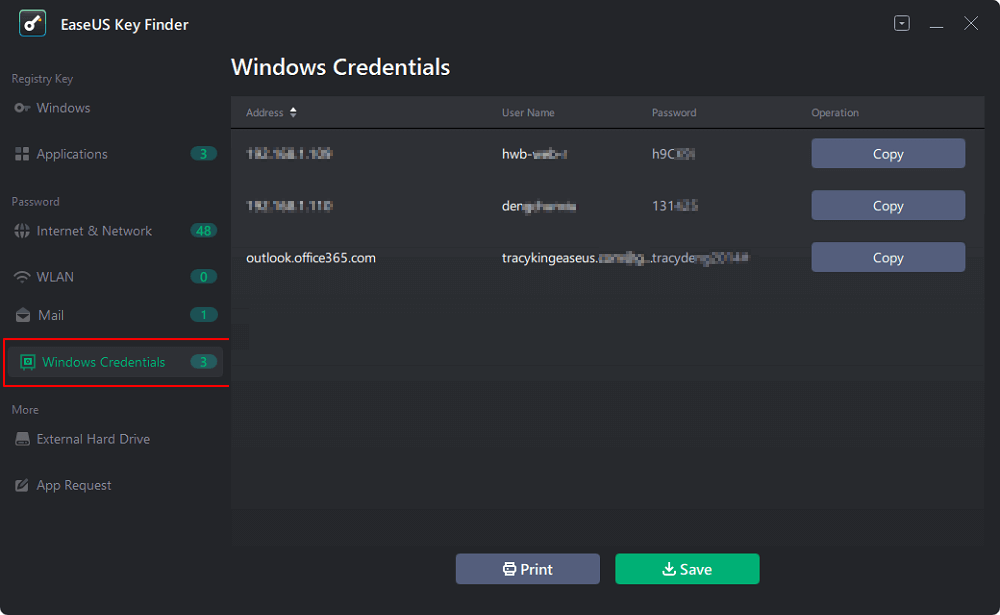
Step 2. Now, you can check all available Windows Credential addresses with respective user names, and passwords.
You can click «Copy», «Print», or «Save» these Windows Credentials’ accounts and passwords at one time.
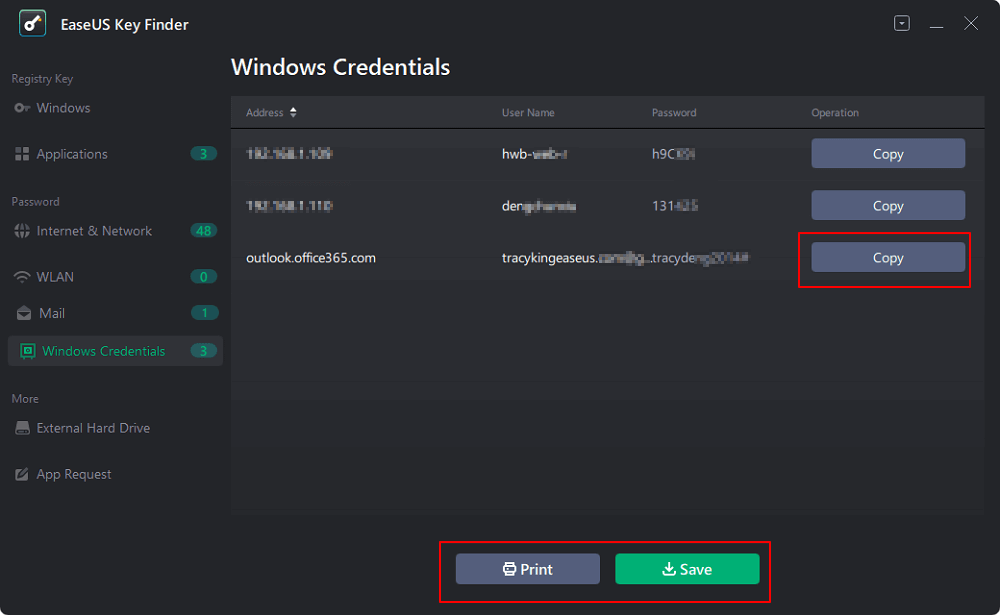
Advantages Of Using EaseUS Key Finder:
There are multiple reasons why you should prefer using EaseUS Key Finder to find the username and password of your Windows 10 computer:
- Besides retrieving Windows passwords, it can also recover lost product keys of Adobe and Microsoft Office.
- You can also find WiFi passwords with the help of this particular product.
- Without putting the data on compromise, EaseUS Key Finder returns accurate results to its users.
Compared with other tools, EaseUS Key Finder ensures it operates for the user. Rather than putting them in difficulty, it takes up the entire process, making it a preferable choice in the market.
Way 2: Find Computer Username and Password via Credential Manager
The Credential Manager holds all the saved passwords across the Windows device and the web. For example, find an Internet Explorer account and password. The data is retrievable when finding the username and password through Credential Manager. Although you won’t be displayed with the entire password against a particular username, other things can be practiced:
Step 1: You have to launch the «Control Panel» of your Windows 10 computer by typing the required option in the «Search» bar at the bottom of the screen.

Step 2: As you continue with the «Control Panel» opening on another window, Proceed to «User Accounts» to access the administrator details of your computer.
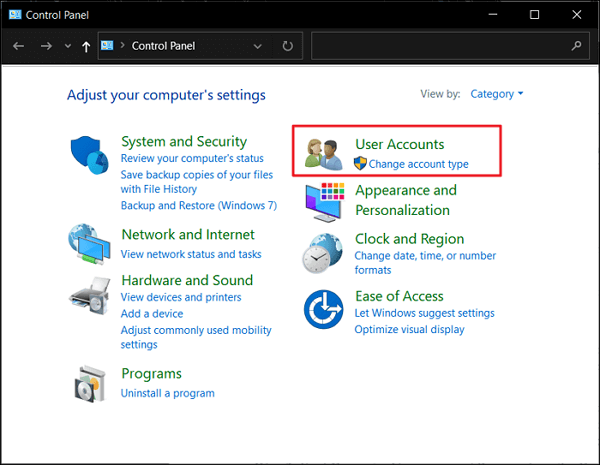
Step 3: Continue into the «Credential Manager» on the next screen and find yourselves in a window where you can adequately manage your Windows 10 credentials. From the available options, select «Windows Credentials» to proceed with the specific options.

Step 4: From the list of credentials, look for the specific detail in the «Windows Credentials» section. Click on the drop-down icon to open its details and continue to select the option of «Remove» to delete these credentials.

Step 5: As there is no particular way to observe the credentials through the Credential Manager, you can delete the previous ones and continue to create a new Windows credential by tapping the «Add a Windows credential» option. This opens a new screen where you can provide all the details to create a new one.
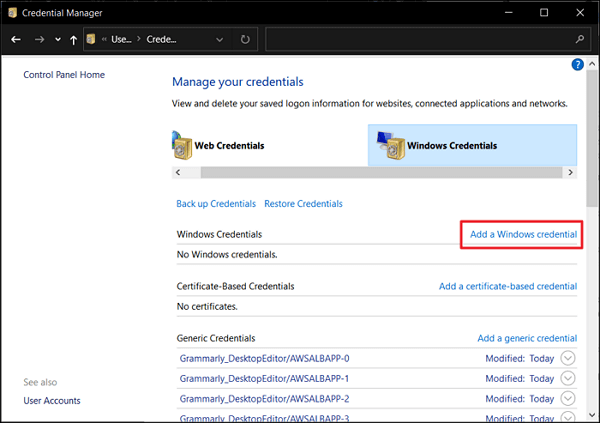
Way 3: Find Computer Username and Password via the Command Prompt
You can find administrator password Windows 10 using Command Prompt. When using the Credential Manager, insert the administrative password to access the details of the username and password stored in Windows 10. If this is the case and you do not remember your administrator password, using the command line can be another impressive option. Find out how to find a computer username and password in Windows 10 with Command Prompt:
Step 1: Access the «Search» bar from your computer’s taskbar and type «CMD» in the provided space to display the options on the screen. As you find the respective option, right-click the «Command Prompt» and choose «Run as administrator.»
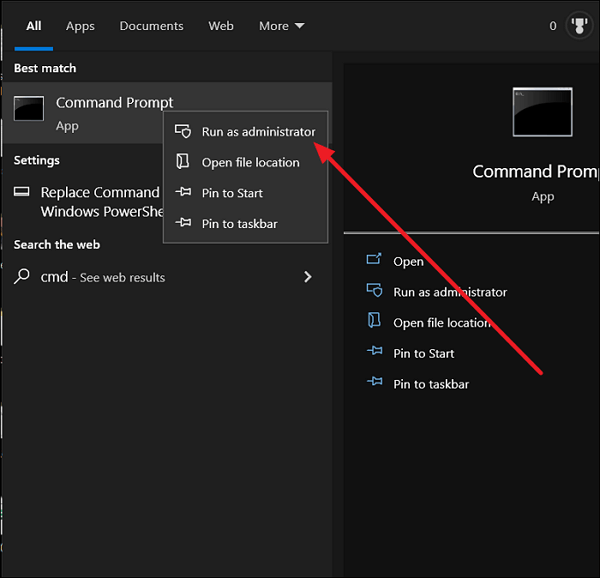
Step 2: After getting prompted to a new window, the command line window will open on your Windows 10 computer. Continue to write the following command in the «Command Prompt»:
rundll32.exe keymgr.dll,KRShowKeyMgr
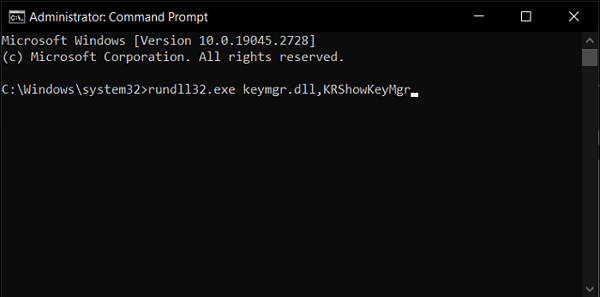
Step 3: As you hit «Enter,» a new window containing the details of the usernames and passwords will open. You can look into the multiple usernames and passwords from the «Stored User Names and Passwords» window. You can back up and restore the details of the passwords and usernames on other desktops if needed.
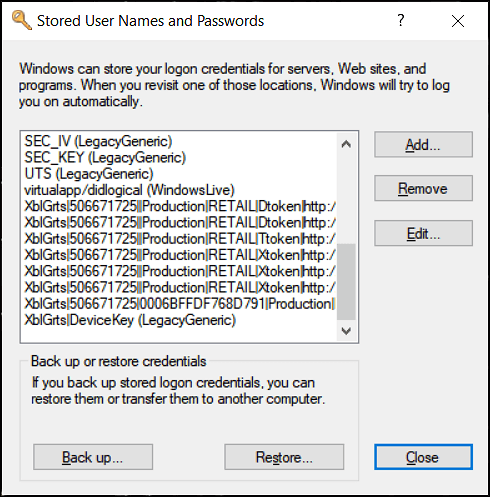
Way 4: Find Computer Username and Password via Registry Editor
Registry Editor can also serve a great purpose in helping users find the username and password credentials within Windows 10. While you must stay careful with the process, using the Windows Registry can provide the required results. When the need arises to access the administrator password of the Windows computer, the guide provided next is optimal:
Step 1: Using the «Window + S» shortcut key, open the «Search» bar from the taskbar at the bottom. As it opens, type regedit to launch the «Registry Editor» on the computer.

Step 2: Follow the navigation below to show Windows credential password:
Computer\HKEY_LOCAL_MACHINE\SOFTWARE\Microsoft\Windows NT\CurrentVersion\Winlogon

Step 3: Go through the list to find the «DefaultPassword» file after accessing the folder. Double-click to launch it and get hold of the stored passwords within the computer.
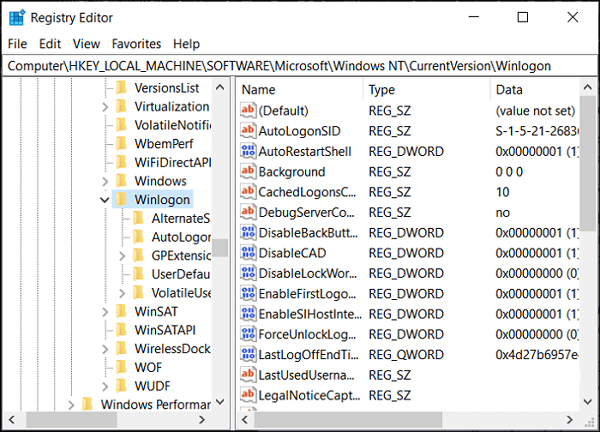
Conclusion
The article has provided a variety of methods that can be used to figure out how to find a computer username and password for Windows 10. With all the discussed details, you have seen the diversity of the existing techniques in helping you find the username and passwords. However, it is only practical sometimes.
EaseUS Key Finder has extensively used its tool to guide users to find the credentials within a specific computer. Download and consider opting for this utility for finding your forgotten username and password of Windows devices every time.
If you want to know more information about how to recover or find usernames and passwords on other applications or browsers, click the below link to learn:
FAQs About Find Computer Username and Password in Windows 10
The provided FAQs display a composite guideline for finding the computer username and password in Windows 10. However, we do hope that you will discover the answers to your questions below:
1. Where are the passwords stored in Windows 10?
To locate the passwords stored within the Windows 10 computer, find them in the Credential Manager window, which can be accessed from:
Step 1: Open the Run program with the «Windows + R» shortcut key. Type in inetcpl.cpl and proceed to launch the command.
Step 2: With the open window, redirect to the «Content» tab from the top. Proceed to the «Settings» button under the «AutoComplete» section.
Step 3: As a new window opens, select «Manage Passwords» to open the «Credential Manager» on your Windows computer.
2. How can I find my computer username using CMD?
To discover the computer username that you are using on your Windows computer, follow the simple steps discussed below:
Step 1: Open the «Command Prompt» window by typing it in the «Search» bar on the taskbar below.
Step 2: Once it opens, use the command whoami to get the current username of your Windows 10 device.
3. What are the computer username and password?
The computer username and password act as the identifier and authenticator, respectively. To make a computer different, its username and password are defined, which can only be accessed by an individual or a group.
Have you ever forgotten a password and wished you could just view it instead of going through the tedious process of resetting it? Well, if you’re a Windows 10 user, you’re in luck! In this blog post, we will explore various methods to view user passwords on Windows 10. Whether you need to recover your own forgotten password or you’re assisting a friend who has lost access to their account, these methods will come in handy. We will discuss the steps for each method in detail, along with their pros and cons. So, let’s dive in and learn how to view user passwords on Windows 10!
Video Tutorial:
The Challenge of Viewing User Passwords on Windows 10
Windows 10 is designed with security in mind, and this includes protecting user passwords. As a result, viewing user passwords directly from Windows settings is not a straightforward task. Microsoft has implemented measures to prevent unauthorized access to user passwords as part of their commitment to user privacy and security. However, there are still methods available that can help you view user passwords on Windows 10. In the following sections, we will explore these methods.
Things You Should Prepare for
Before we dive into the methods, there are a few things you should prepare for to ensure a smooth process. Here’s a list of things you’ll need:
1. Access to an administrator account: To view user passwords on Windows 10, you’ll need administrative privileges on the computer.
2. Physical access to the computer: You’ll need physical access to the computer on which you want to view the user password. Remote methods are not covered in this blog post.
3. Basic technical knowledge: While the methods outlined in this blog post are relatively straightforward, having some basic technical knowledge will be helpful.
Now that you’re prepared, let’s explore the methods to view user passwords on Windows 10!
Method 1: How to View User Passwords via Windows Settings
To view user passwords via Windows settings, follow these steps:
1. Press the Windows key + I on your keyboard to open the Windows Settings.
2. Click on “Accounts” to open the Accounts settings page.
3. In the left sidebar, click on “Sign-in options.”
4. Scroll down to the “Password” section and click on “Manage your sign-in info.”
5. You’ll be prompted to enter your password or use a fingerprint/Windows Hello to access your account info. Enter the required credentials to proceed.
6. Under the “Passwords” section, you’ll see a list of saved credentials. Locate the desired account and click on it.
7. Click on the “Show” button next to the password field to view the password.
Pros:
| Pros | 1. Easy to access via Windows Settings. | 2. Does not require third-party software. | 3. User-friendly interface. |
|---|---|---|---|
| Cons: | 1. Can only view passwords for accounts linked to the Microsoft account. | 2. Requires administrative privileges. | 3. Passwords are displayed in plain text, potentially compromising security if someone gains unauthorized access to your account. |
Method 2: How to View User Passwords Using Command Prompt
To view user passwords using Command Prompt, follow these steps:
1. Open Command Prompt by pressing the Windows key + X and selecting “Command Prompt” from the menu.
2. Type the following command and press Enter: net user
3. You’ll see a list of user accounts on the computer. Identify the account for which you want to view the password.
4. Type the following command and press Enter, replacing “username” with the actual username: net user username
5. The command prompt will display various details about the user account, including the password (encrypted).
Pros:
| Pros | 1. Built-in feature in Windows, so no need for third-party software. | 2. Can be used to view passwords for both local and domain accounts. | 3. Does not require an internet connection. |
|---|---|---|---|
| Cons: | 1. Passwords are displayed in encrypted form. | 2. Requires administrative privileges. | 3. Not suitable for users without technical knowledge. |
Method 3: How to View User Passwords Using a Password Reset Disk
To view user passwords using a password reset disk, follow these steps:
1. Insert the password reset disk into the computer for which you want to view the password.
2. On the login screen, click on “Reset password.”
3. Follow the on-screen instructions to create a new password for the account.
4. Once the password reset is successful, you’ll be able to log in with the new password.
Pros:
| Pros | 1. Can be used to view passwords for both local and domain accounts. | 2. Provides a secure way to reset passwords. | 3. Doesn’t require administrative access to the computer. |
|---|---|---|---|
| Cons: | 1. Requires a previously created password reset disk. | 2. Only works if a password reset disk was created before forgetting the password. | 3. Not suitable for immediate password recovery. |
Method 4: How to View User Passwords Using Third-Party Software
To view user passwords using third-party software, follow these steps:
1. Research and identify a reputable password recovery software that supports Windows 10.
2. Download and install the selected software on a separate computer.
3. Launch the software and follow the on-screen instructions to create a password recovery disk or USB drive.
4. Insert the password recovery disk or USB drive into the computer for which you want to view the password.
5. Restart the computer and boot from the password recovery disk or USB drive.
6. Follow the software’s instructions to view the user passwords on the computer.
Pros:
| Pros | 1. Can be used to view passwords for both local and domain accounts. | 2. Can recover passwords even when other methods fail. | 3. Some software offers additional features like password removal or account unlocking. |
|---|---|---|---|
| Cons: | 1. Requires downloading and installing third-party software. | 2. May come at a cost if purchasing a premium version of the software. | 3. Potential risk of malware or data breach if using untrustworthy software. |
Why Can’t I View User Passwords?
There are several reasons why you may encounter difficulties viewing user passwords on Windows 10. Here are a few common reasons and their fixes:
1. Reason: User account type. If you’re using a standard user account, you won’t have the necessary privileges to view passwords.
Fix: Login with an administrator account or ask the administrator to provide the password.
2. Reason: Microsoft account authentication. If you’re using a Microsoft account to sign in, the password is managed by Microsoft and cannot be viewed directly within Windows settings.
Fix: Reset the password through the Microsoft account recovery process or use one of the other methods mentioned in this blog post.
3. Reason: Encrypted passwords. Windows encrypts user passwords for security purposes, making it difficult to view them directly.
Fix: Use a password recovery software or reset the password through other methods mentioned in this blog post.
Additional Tips
Here are some additional tips to keep in mind when trying to view user passwords on Windows 10:
1. Regularly back up important passwords using a secure password manager.
2. Use strong, unique passwords for each account to minimize the impact of a compromised password.
3. Keep your computer and accounts secure by enabling two-factor authentication whenever possible.
5 FAQs about Viewing User Passwords on Windows 10
Q1: Can I view passwords for accounts that are not linked to a Microsoft account?
A: No, the methods mentioned in this blog post primarily apply to accounts linked to Microsoft accounts. For local user accounts or domain accounts, different methods may be required.
Q2: Are there any risks associated with using third-party password recovery software?
A: Yes, there is a potential risk of downloading and using untrustworthy or malicious software. It’s important to research and use reputable software from trusted sources.
Q3: Is it legal to view someone else’s password without their consent?
A: It is generally illegal to view someone else’s password without their consent, as it violates privacy and security laws. Always ensure you have the necessary permissions before attempting to view or recover passwords.
Q4: Can I use the methods mentioned in this blog post to view passwords on Windows 7 or older versions?
A: The methods mentioned in this blog post are primarily focused on Windows 10. For older versions of Windows, different methods may be required.
Q5: Is it recommended to view user passwords?
A: The act of viewing user passwords should only be done for legitimate reasons, such as password recovery or technical support. It is generally recommended to use secure password management practices and respect user privacy.
In Conclusion
While viewing user passwords on Windows 10 may seem challenging at first, there are methods available to assist in password recovery. Whether it’s through Windows Settings, Command Prompt, a password reset disk, or third-party software, each method has its pros and cons. It’s essential to understand the risks and legal implications associated with viewing user passwords and to always obtain the necessary permissions. Remember to prioritize user privacy and security, and employ strong password management practices to avoid the need for password recovery in the first place.{“@context”:”https://schema.org”,”@type”:”FAQPage”,”mainEntity”:[{“@type”:”Question”,”name”:” Can I view passwords for accounts that are not linked to a Microsoft account?”,”acceptedAnswer”:{“@type”:”Answer”,”text”:” No, the methods mentioned in this blog post primarily apply to accounts linked to Microsoft accounts. For local user accounts or domain accounts, different methods may be required.”}},{“@type”:”Question”,”name”:” Are there any risks associated with using third-party password recovery software?”,”acceptedAnswer”:{“@type”:”Answer”,”text”:” Yes, there is a potential risk of downloading and using untrustworthy or malicious software. It’s important to research and use reputable software from trusted sources.”}},{“@type”:”Question”,”name”:” Is it legal to view someone else’s password without their consent?”,”acceptedAnswer”:{“@type”:”Answer”,”text”:” It is generally illegal to view someone else’s password without their consent, as it violates privacy and security laws. Always ensure you have the necessary permissions before attempting to view or recover passwords.”}},{“@type”:”Question”,”name”:” Can I use the methods mentioned in this blog post to view passwords on Windows 7 or older versions?”,”acceptedAnswer”:{“@type”:”Answer”,”text”:” The methods mentioned in this blog post are primarily focused on Windows 10. For older versions of Windows, different methods may be required.”}},{“@type”:”Question”,”name”:” Is it recommended to view user passwords?”,”acceptedAnswer”:{“@type”:”Answer”,”text”:” The act of viewing user passwords should only be done for legitimate reasons, such as password recovery or technical support. It is generally recommended to use secure password management practices and respect user privacy.”}}]}
Finding your computer username and password on Windows 11 is a straightforward process that guides you through accessing and viewing your account information. This can help you log in or troubleshoot issues with your account. Below, we’ll walk you through the steps to locate both your username and password on Windows 11.
In this section, we’ll go through the necessary steps to find your computer’s username and password in Windows 11.
Step 1: Open the Settings Menu
To start, open the Settings menu by clicking on the Start button and then selecting “Settings” from the options.
The Settings menu is your gateway to almost all system configurations. This is where you can manage your accounts, adjust settings, and get info about your PC.
Step 2: Navigate to Accounts
Next, in the Settings menu, click on “Accounts.”
The Accounts section lets you manage your user information, including your username. This is the place to go when you need to update your profile details or configure account settings.
Step 3: View Your Username
Under the “Your info” tab, you will see your username displayed.
Your username is your unique identifier on the computer. It’s crucial to know this, especially when setting up network connections or sharing files.
Step 4: Open Control Panel
To find your password, open the Control Panel by typing “Control Panel” in the search bar and selecting it from the results.
The Control Panel provides access to more advanced settings. It’s where you can change system preferences and manage user accounts at a deeper level.
Step 5: Navigate to User Accounts
Once in the Control Panel, select “User Accounts.”
This section allows you to manage passwords and other security settings. It’s an essential tool for keeping your account secure.
Step 6: Manage Your Credentials
Select “Credential Manager” to view your saved passwords.
Credential Manager stores your saved usernames and passwords. This is where you can view or edit your credentials for different apps and services.
After completing these steps, you’ll be able to view your username and password, helping you regain access to your account or troubleshoot login issues.
Tips for Finding Computer Username and Password on Windows 11
- Always use a strong and unique password for each account to enhance security.
- Regularly update your password to protect your account from unauthorized access.
- Use a password manager to keep track of your various credentials.
- Enable two-factor authentication for an added layer of security.
- Write down your username and password in a secure place if you tend to forget them.
Frequently Asked Questions
Can I find my password directly on Windows 11?
No, Windows 11 does not show your password directly for security reasons. You can use Credential Manager to view saved passwords for specific apps and services.
How do I reset my Windows 11 password if I forgot it?
Use the “Forgot Password” option on the login screen, which will guide you through the steps to reset it, usually via a linked email or phone number.
Can I change my username on Windows 11?
Yes, you can change your username by going to the Accounts section in Settings and editing your profile information.
Is it safe to store passwords in Credential Manager?
While Credential Manager is reasonably secure, using a dedicated password manager with added encryption can provide better security.
What should I do if I suspect someone has access to my account?
Immediately change your password, enable two-factor authentication, and review account activity to ensure there are no unauthorized changes.
Summary
- Open the Settings Menu.
- Navigate to Accounts.
- View Your Username.
- Open Control Panel.
- Navigate to User Accounts.
- Manage Your Credentials.
Conclusion
Finding your computer username and password on Windows 11 is a simple yet essential process for maintaining your account’s security and accessibility. By following the steps outlined above, you can quickly locate your username and manage your passwords through Credential Manager. Remember, maintaining strong, unique passwords and using additional security measures like two-factor authentication can significantly enhance your account’s safety.
For further reading on Windows 11 security features, you can explore additional resources or consult Microsoft’s official documentation. Keeping your information secure is crucial, so always stay informed and proactive in managing your digital credentials.
Matthew Burleigh has been writing tech tutorials since 2008. His writing has appeared on dozens of different websites and been read over 50 million times.
After receiving his Bachelor’s and Master’s degrees in Computer Science he spent several years working in IT management for small businesses. However, he now works full time writing content online and creating websites.
His main writing topics include iPhones, Microsoft Office, Google Apps, Android, and Photoshop, but he has also written about many other tech topics as well.
Read his full bio here.
Stored User Names and passwords in Windows lets you access automatically various accounts on websites for examples, applications, servers, resources; all of this without having to enter your password every single time. It’s certainly a useful feature. However, if you are curious or for some reason want to delete some password you might find yourself asking: how do I find the passwords used on my computer Windows 10/8/7? Read below to find out how to do it. There is a different way depending on your system so heads up!
- Way 1: How to find the stored user names and passwords in Windows 10
- Way 2: How to find the stored user names and passwords in Windows 7/8
- Way 3: How to find the stored passwords using WinPassKey
Way 1: How to find the stored user names and passwords in Windows 10
If you are a Windows 10 user, then follow these steps to find passwords used on your Windows 10 computer:
Way 2: How to find the stored user names and passwords in Windows 7/8
To manage the stored user names in Windows 7/8 just:
Way 3: How to find the stored passwords using WinPassKey
If the above options were too techy, here is another thing you can try to find the password that have been used on your Windows 10/8/7. A great way to find them is to use WinPassKey. It is an all-in-one Windows password recovery tool, helps you recover forgotten passwords in a few minutes and allows you to create a new administrator account easily without logon. You will need another computer where you can download the program so time to call in some favours! To use WinPassKey follow these steps:
10,000+ Downloads
Key Features:
- It can recover forgotten password for all Windows in a few minutes.
- It can create a new administrator account easily without logon.
- It can create USB flash drive disk or CD/DVD Disc.
- Support Windows 10, 8.1, 8, 7, Vista, XP, 2000, NT.
- Support Windows Server 2016, 2012, 2008(R2), 2003(R2), 2000, NT.
Free Download
Buy Now
Summary
In this post, we explained 3 different ways to find passwords used on your computer Windows 10/8/7. Don’t forget to like the post if it was useful and if you still have problems with your device don’t hesitate to contact us.
Free Download
Buy Now
